NUR2300, Semester 3: Evidence-Based Hand Hygiene Practice Report
VerifiedAdded on 2022/09/01
|12
|2791
|23
Report
AI Summary
This report examines the effectiveness of hand hygiene practices in acute care settings, focusing on the use of alcohol-based hand sanitizers. It begins with an introduction highlighting the significance of hand hygiene in preventing healthcare-associated infections and the importance of proper handwashing techniques. The report establishes a PICO question to guide the evidence review, focusing on the effectiveness of alcohol-based hand sanitizers compared to soap and water in reducing infections. The methodology includes inclusion and exclusion criteria for literature searches, along with the use of the CASP tool for article appraisal. The analysis synthesizes evidence from various studies, including cross-sectional surveys and systematic reviews, to assess the impact of hand hygiene training, the WHO 6-step technique, and patient hand hygiene practices on infection rates. The findings emphasize the importance of alcohol-based hand rubs, the need for consistent hand hygiene compliance among healthcare professionals, and the role of patient involvement in hand hygiene. The report concludes with recommendations for practice, such as increased education and monitoring, and suggests further research to improve hand hygiene protocols. The report also includes a discussion of relevant studies and their findings, such as the impact of the WHO 6-step hand hygiene technique, the effectiveness of alcohol-based hand rubs, and the importance of patient hand hygiene practices. The report recommends that hospitals should conduct self-reporting and monitoring processes and increase awareness among patients.
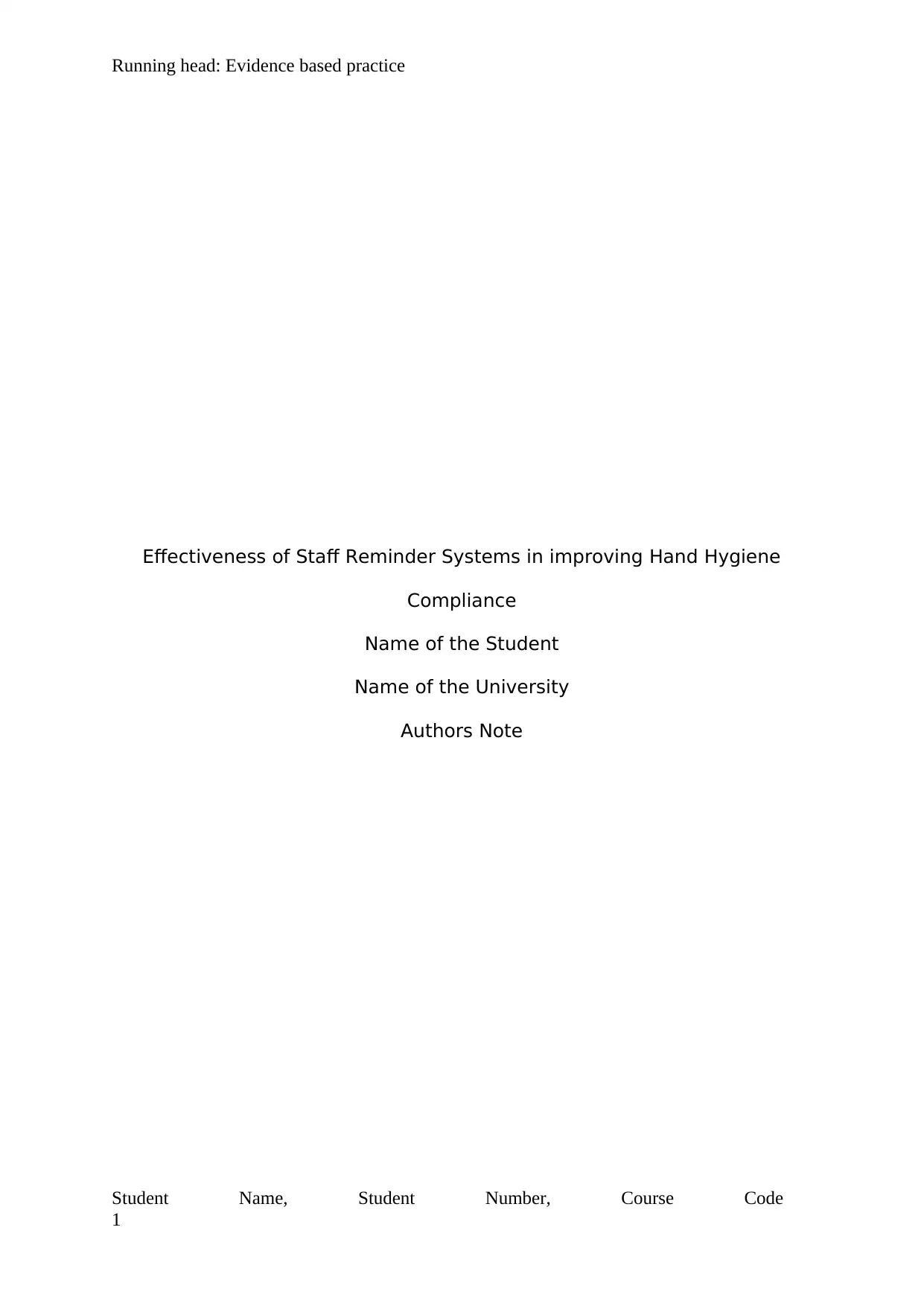
Running head: Evidence based practice
Effectiveness of Staff Reminder Systems in improving Hand Hygiene
Compliance
Name of the Student
Name of the University
Authors Note
Student Name, Student Number, Course Code
1
Effectiveness of Staff Reminder Systems in improving Hand Hygiene
Compliance
Name of the Student
Name of the University
Authors Note
Student Name, Student Number, Course Code
1
Paraphrase This Document
Need a fresh take? Get an instant paraphrase of this document with our AI Paraphraser
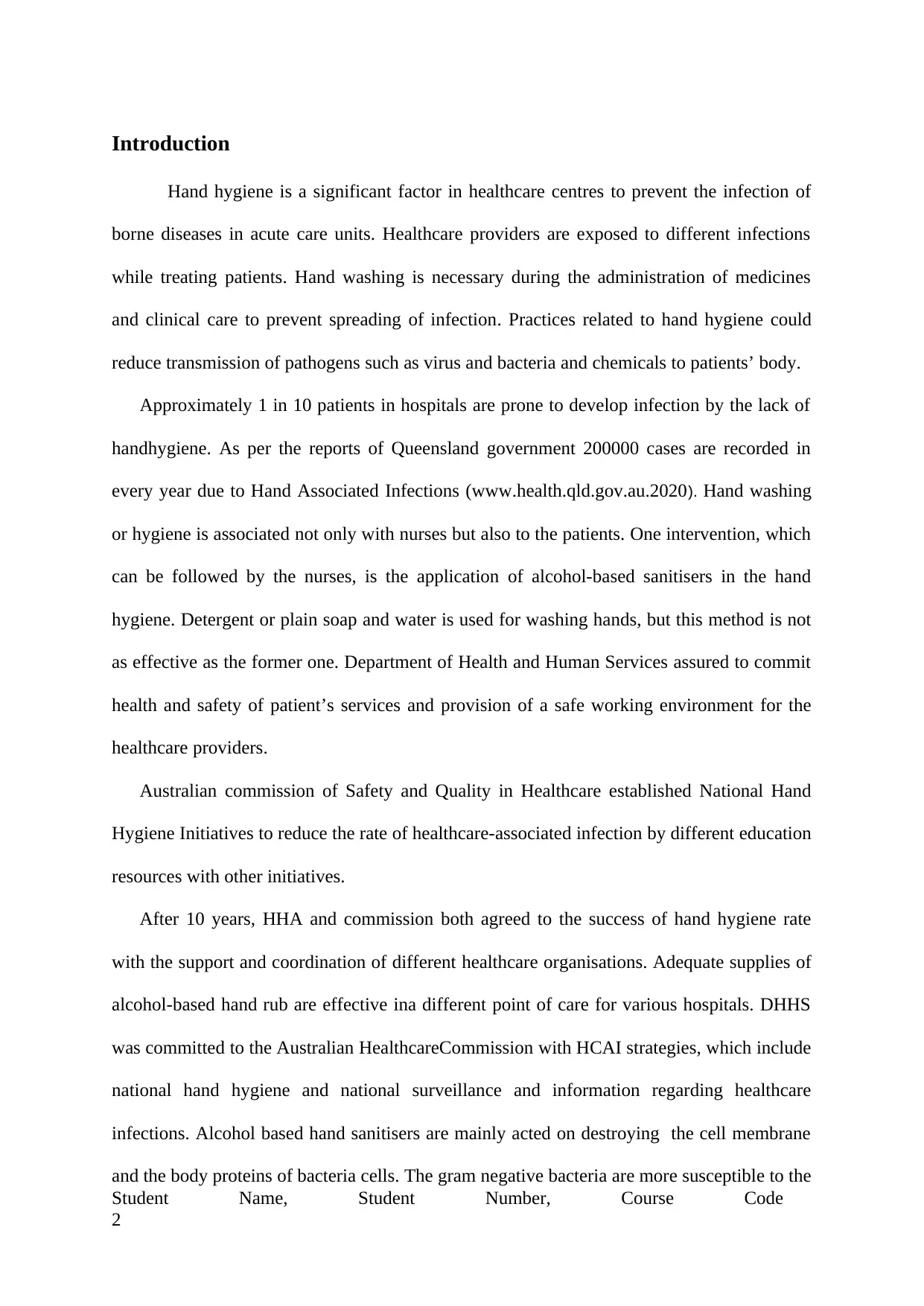
Introduction
Hand hygiene is a significant factor in healthcare centres to prevent the infection of
borne diseases in acute care units. Healthcare providers are exposed to different infections
while treating patients. Hand washing is necessary during the administration of medicines
and clinical care to prevent spreading of infection. Practices related to hand hygiene could
reduce transmission of pathogens such as virus and bacteria and chemicals to patients’ body.
Approximately 1 in 10 patients in hospitals are prone to develop infection by the lack of
handhygiene. As per the reports of Queensland government 200000 cases are recorded in
every year due to Hand Associated Infections (www.health.qld.gov.au.2020). Hand washing
or hygiene is associated not only with nurses but also to the patients. One intervention, which
can be followed by the nurses, is the application of alcohol-based sanitisers in the hand
hygiene. Detergent or plain soap and water is used for washing hands, but this method is not
as effective as the former one. Department of Health and Human Services assured to commit
health and safety of patient’s services and provision of a safe working environment for the
healthcare providers.
Australian commission of Safety and Quality in Healthcare established National Hand
Hygiene Initiatives to reduce the rate of healthcare-associated infection by different education
resources with other initiatives.
After 10 years, HHA and commission both agreed to the success of hand hygiene rate
with the support and coordination of different healthcare organisations. Adequate supplies of
alcohol-based hand rub are effective ina different point of care for various hospitals. DHHS
was committed to the Australian HealthcareCommission with HCAI strategies, which include
national hand hygiene and national surveillance and information regarding healthcare
infections. Alcohol based hand sanitisers are mainly acted on destroying the cell membrane
and the body proteins of bacteria cells. The gram negative bacteria are more susceptible to the
Student Name, Student Number, Course Code
2
Hand hygiene is a significant factor in healthcare centres to prevent the infection of
borne diseases in acute care units. Healthcare providers are exposed to different infections
while treating patients. Hand washing is necessary during the administration of medicines
and clinical care to prevent spreading of infection. Practices related to hand hygiene could
reduce transmission of pathogens such as virus and bacteria and chemicals to patients’ body.
Approximately 1 in 10 patients in hospitals are prone to develop infection by the lack of
handhygiene. As per the reports of Queensland government 200000 cases are recorded in
every year due to Hand Associated Infections (www.health.qld.gov.au.2020). Hand washing
or hygiene is associated not only with nurses but also to the patients. One intervention, which
can be followed by the nurses, is the application of alcohol-based sanitisers in the hand
hygiene. Detergent or plain soap and water is used for washing hands, but this method is not
as effective as the former one. Department of Health and Human Services assured to commit
health and safety of patient’s services and provision of a safe working environment for the
healthcare providers.
Australian commission of Safety and Quality in Healthcare established National Hand
Hygiene Initiatives to reduce the rate of healthcare-associated infection by different education
resources with other initiatives.
After 10 years, HHA and commission both agreed to the success of hand hygiene rate
with the support and coordination of different healthcare organisations. Adequate supplies of
alcohol-based hand rub are effective ina different point of care for various hospitals. DHHS
was committed to the Australian HealthcareCommission with HCAI strategies, which include
national hand hygiene and national surveillance and information regarding healthcare
infections. Alcohol based hand sanitisers are mainly acted on destroying the cell membrane
and the body proteins of bacteria cells. The gram negative bacteria are more susceptible to the
Student Name, Student Number, Course Code
2
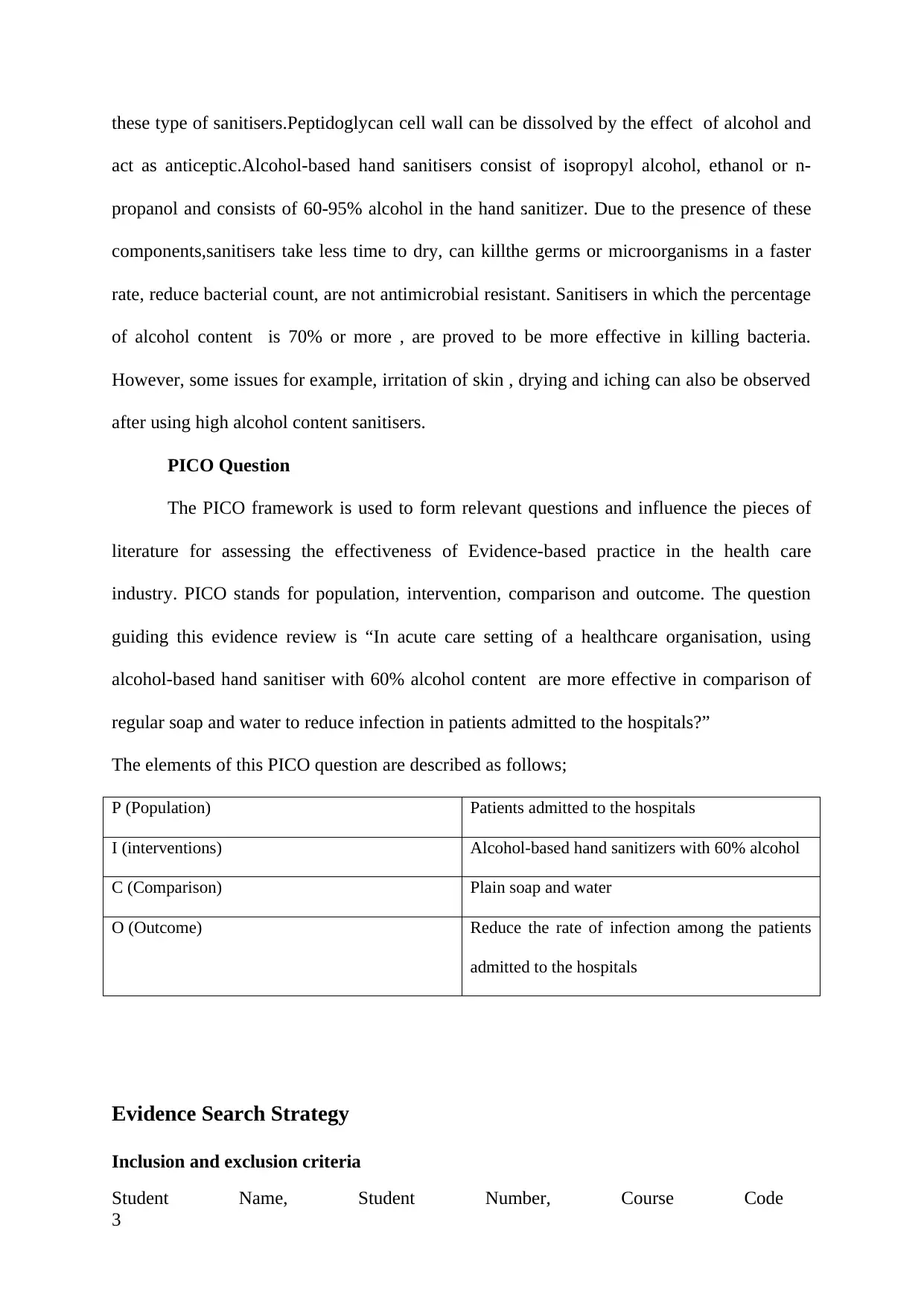
these type of sanitisers.Peptidoglycan cell wall can be dissolved by the effect of alcohol and
act as anticeptic.Alcohol-based hand sanitisers consist of isopropyl alcohol, ethanol or n-
propanol and consists of 60-95% alcohol in the hand sanitizer. Due to the presence of these
components,sanitisers take less time to dry, can killthe germs or microorganisms in a faster
rate, reduce bacterial count, are not antimicrobial resistant. Sanitisers in which the percentage
of alcohol content is 70% or more , are proved to be more effective in killing bacteria.
However, some issues for example, irritation of skin , drying and iching can also be observed
after using high alcohol content sanitisers.
PICO Question
The PICO framework is used to form relevant questions and influence the pieces of
literature for assessing the effectiveness of Evidence-based practice in the health care
industry. PICO stands for population, intervention, comparison and outcome. The question
guiding this evidence review is “In acute care setting of a healthcare organisation, using
alcohol-based hand sanitiser with 60% alcohol content are more effective in comparison of
regular soap and water to reduce infection in patients admitted to the hospitals?”
The elements of this PICO question are described as follows;
P (Population) Patients admitted to the hospitals
I (interventions) Alcohol-based hand sanitizers with 60% alcohol
C (Comparison) Plain soap and water
O (Outcome) Reduce the rate of infection among the patients
admitted to the hospitals
Evidence Search Strategy
Inclusion and exclusion criteria
Student Name, Student Number, Course Code
3
act as anticeptic.Alcohol-based hand sanitisers consist of isopropyl alcohol, ethanol or n-
propanol and consists of 60-95% alcohol in the hand sanitizer. Due to the presence of these
components,sanitisers take less time to dry, can killthe germs or microorganisms in a faster
rate, reduce bacterial count, are not antimicrobial resistant. Sanitisers in which the percentage
of alcohol content is 70% or more , are proved to be more effective in killing bacteria.
However, some issues for example, irritation of skin , drying and iching can also be observed
after using high alcohol content sanitisers.
PICO Question
The PICO framework is used to form relevant questions and influence the pieces of
literature for assessing the effectiveness of Evidence-based practice in the health care
industry. PICO stands for population, intervention, comparison and outcome. The question
guiding this evidence review is “In acute care setting of a healthcare organisation, using
alcohol-based hand sanitiser with 60% alcohol content are more effective in comparison of
regular soap and water to reduce infection in patients admitted to the hospitals?”
The elements of this PICO question are described as follows;
P (Population) Patients admitted to the hospitals
I (interventions) Alcohol-based hand sanitizers with 60% alcohol
C (Comparison) Plain soap and water
O (Outcome) Reduce the rate of infection among the patients
admitted to the hospitals
Evidence Search Strategy
Inclusion and exclusion criteria
Student Name, Student Number, Course Code
3
⊘ This is a preview!⊘
Do you want full access?
Subscribe today to unlock all pages.

Trusted by 1+ million students worldwide
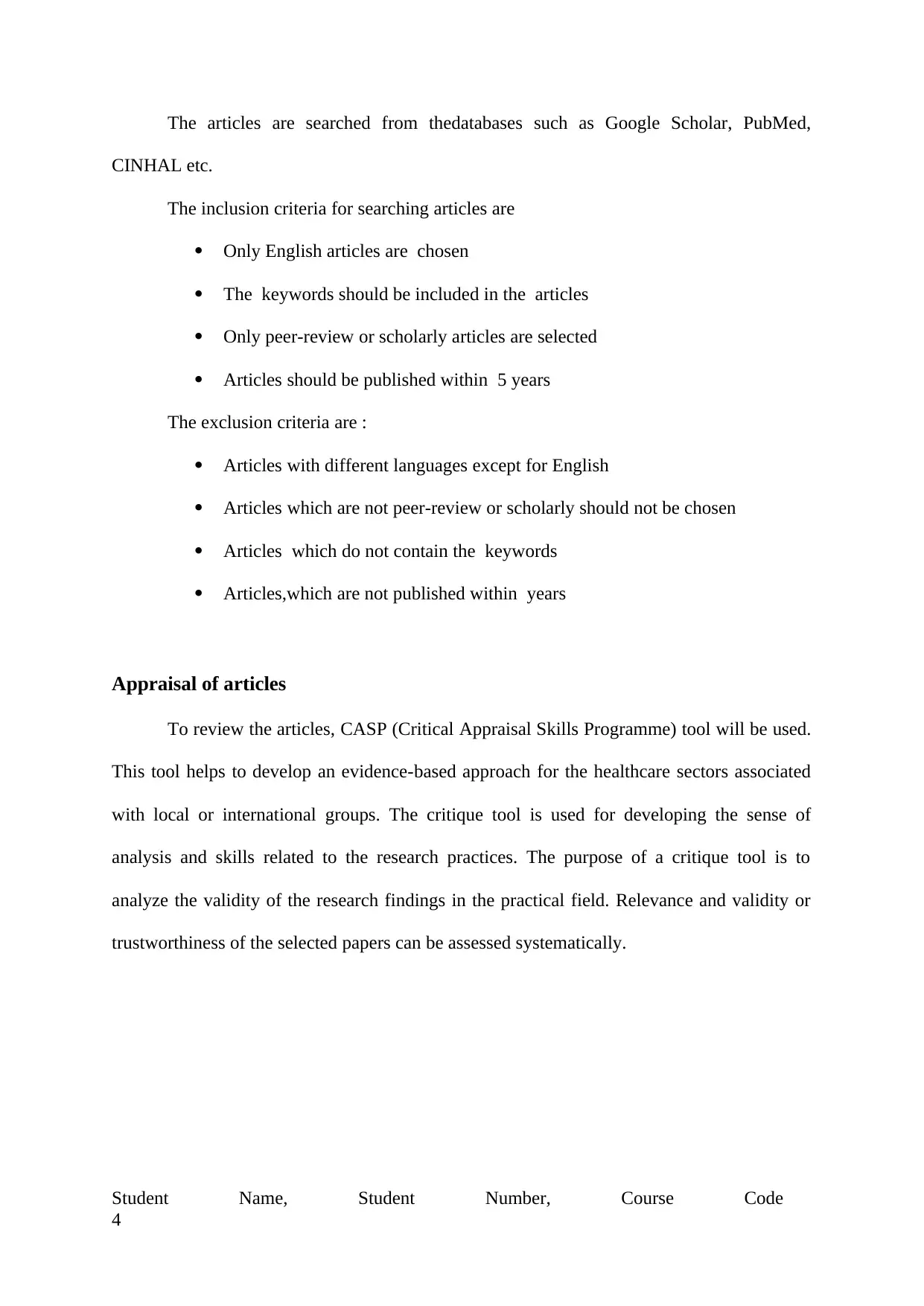
The articles are searched from thedatabases such as Google Scholar, PubMed,
CINHAL etc.
The inclusion criteria for searching articles are
Only English articles are chosen
The keywords should be included in the articles
Only peer-review or scholarly articles are selected
Articles should be published within 5 years
The exclusion criteria are :
Articles with different languages except for English
Articles which are not peer-review or scholarly should not be chosen
Articles which do not contain the keywords
Articles,which are not published within years
Appraisal of articles
To review the articles, CASP (Critical Appraisal Skills Programme) tool will be used.
This tool helps to develop an evidence-based approach for the healthcare sectors associated
with local or international groups. The critique tool is used for developing the sense of
analysis and skills related to the research practices. The purpose of a critique tool is to
analyze the validity of the research findings in the practical field. Relevance and validity or
trustworthiness of the selected papers can be assessed systematically.
Student Name, Student Number, Course Code
4
CINHAL etc.
The inclusion criteria for searching articles are
Only English articles are chosen
The keywords should be included in the articles
Only peer-review or scholarly articles are selected
Articles should be published within 5 years
The exclusion criteria are :
Articles with different languages except for English
Articles which are not peer-review or scholarly should not be chosen
Articles which do not contain the keywords
Articles,which are not published within years
Appraisal of articles
To review the articles, CASP (Critical Appraisal Skills Programme) tool will be used.
This tool helps to develop an evidence-based approach for the healthcare sectors associated
with local or international groups. The critique tool is used for developing the sense of
analysis and skills related to the research practices. The purpose of a critique tool is to
analyze the validity of the research findings in the practical field. Relevance and validity or
trustworthiness of the selected papers can be assessed systematically.
Student Name, Student Number, Course Code
4
Paraphrase This Document
Need a fresh take? Get an instant paraphrase of this document with our AI Paraphraser
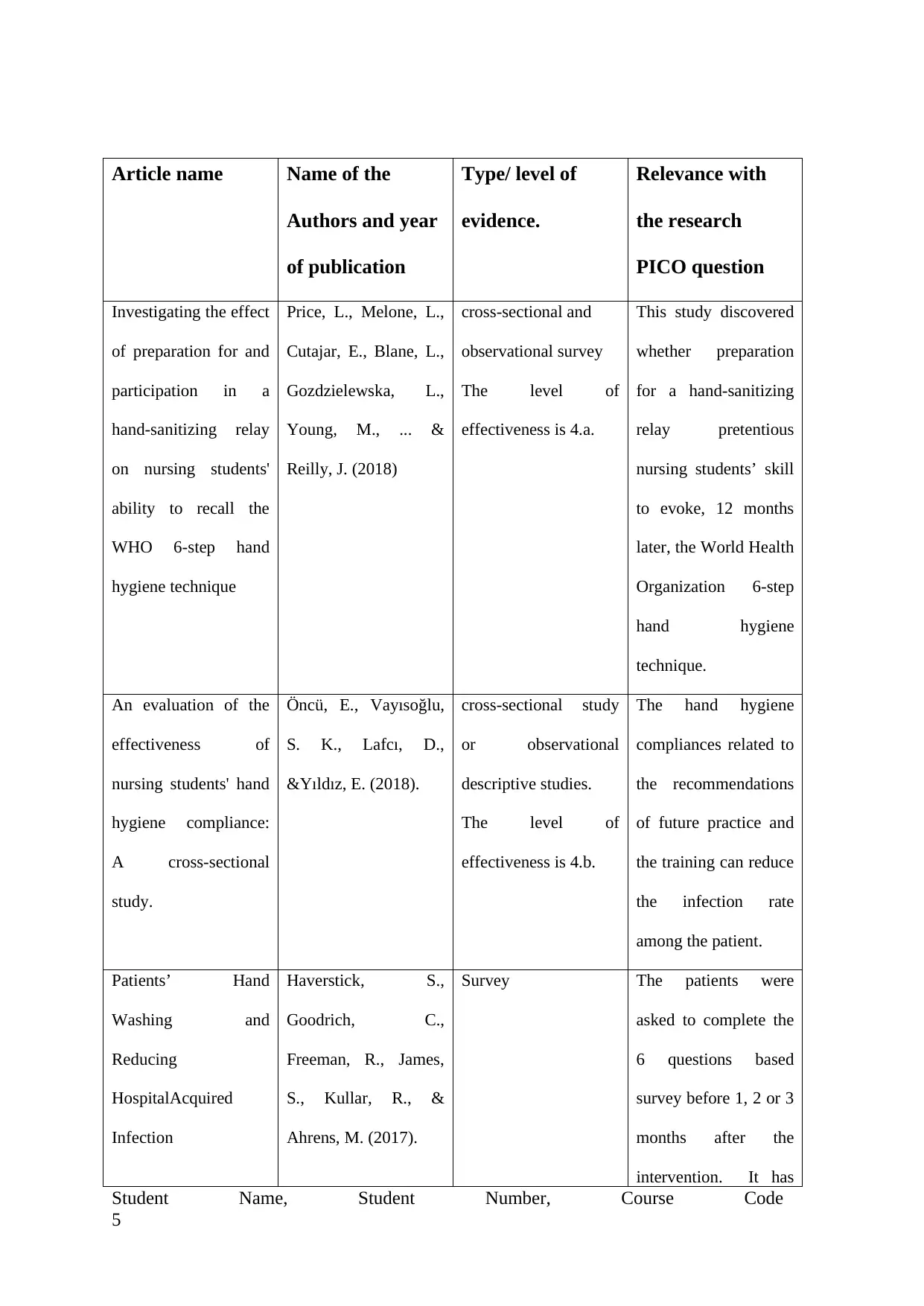
Article name Name of the
Authors and year
of publication
Type/ level of
evidence.
Relevance with
the research
PICO question
Investigating the effect
of preparation for and
participation in a
hand-sanitizing relay
on nursing students'
ability to recall the
WHO 6-step hand
hygiene technique
Price, L., Melone, L.,
Cutajar, E., Blane, L.,
Gozdzielewska, L.,
Young, M., ... &
Reilly, J. (2018)
cross-sectional and
observational survey
The level of
effectiveness is 4.a.
This study discovered
whether preparation
for a hand-sanitizing
relay pretentious
nursing students’ skill
to evoke, 12 months
later, the World Health
Organization 6-step
hand hygiene
technique.
An evaluation of the
effectiveness of
nursing students' hand
hygiene compliance:
A cross-sectional
study.
Öncü, E., Vayısoğlu,
S. K., Lafcı, D.,
&Yıldız, E. (2018).
cross-sectional study
or observational
descriptive studies.
The level of
effectiveness is 4.b.
The hand hygiene
compliances related to
the recommendations
of future practice and
the training can reduce
the infection rate
among the patient.
Patients’ Hand
Washing and
Reducing
HospitalAcquired
Infection
Haverstick, S.,
Goodrich, C.,
Freeman, R., James,
S., Kullar, R., &
Ahrens, M. (2017).
Survey The patients were
asked to complete the
6 questions based
survey before 1, 2 or 3
months after the
intervention. It has
Student Name, Student Number, Course Code
5
Authors and year
of publication
Type/ level of
evidence.
Relevance with
the research
PICO question
Investigating the effect
of preparation for and
participation in a
hand-sanitizing relay
on nursing students'
ability to recall the
WHO 6-step hand
hygiene technique
Price, L., Melone, L.,
Cutajar, E., Blane, L.,
Gozdzielewska, L.,
Young, M., ... &
Reilly, J. (2018)
cross-sectional and
observational survey
The level of
effectiveness is 4.a.
This study discovered
whether preparation
for a hand-sanitizing
relay pretentious
nursing students’ skill
to evoke, 12 months
later, the World Health
Organization 6-step
hand hygiene
technique.
An evaluation of the
effectiveness of
nursing students' hand
hygiene compliance:
A cross-sectional
study.
Öncü, E., Vayısoğlu,
S. K., Lafcı, D.,
&Yıldız, E. (2018).
cross-sectional study
or observational
descriptive studies.
The level of
effectiveness is 4.b.
The hand hygiene
compliances related to
the recommendations
of future practice and
the training can reduce
the infection rate
among the patient.
Patients’ Hand
Washing and
Reducing
HospitalAcquired
Infection
Haverstick, S.,
Goodrich, C.,
Freeman, R., James,
S., Kullar, R., &
Ahrens, M. (2017).
Survey The patients were
asked to complete the
6 questions based
survey before 1, 2 or 3
months after the
intervention. It has
Student Name, Student Number, Course Code
5
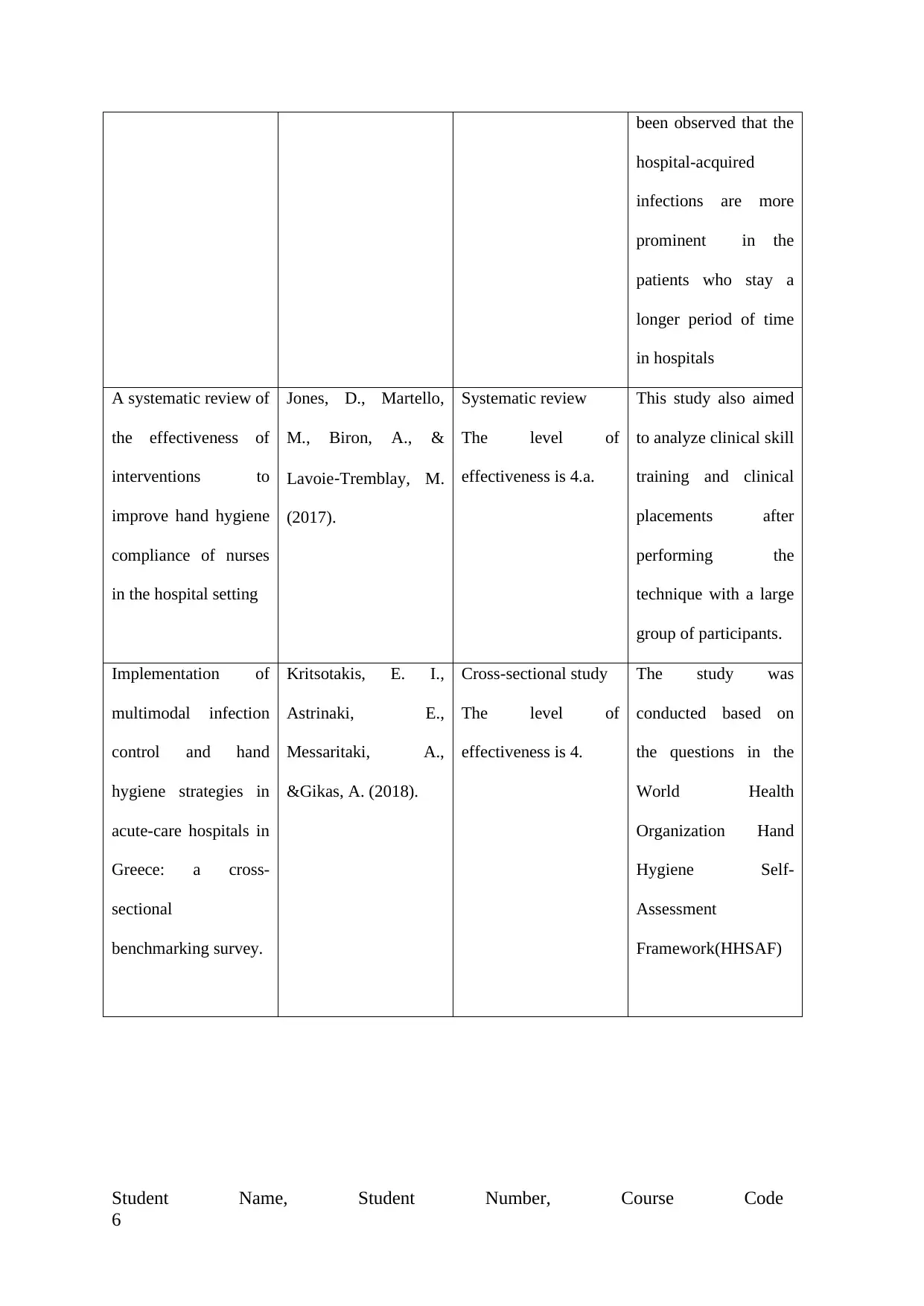
been observed that the
hospital-acquired
infections are more
prominent in the
patients who stay a
longer period of time
in hospitals
A systematic review of
the effectiveness of
interventions to
improve hand hygiene
compliance of nurses
in the hospital setting
Jones, D., Martello,
M., Biron, A., &
Lavoie‐Tremblay, M.
(2017).
Systematic review
The level of
effectiveness is 4.a.
This study also aimed
to analyze clinical skill
training and clinical
placements after
performing the
technique with a large
group of participants.
Implementation of
multimodal infection
control and hand
hygiene strategies in
acute-care hospitals in
Greece: a cross-
sectional
benchmarking survey.
Kritsotakis, E. I.,
Astrinaki, E.,
Messaritaki, A.,
&Gikas, A. (2018).
Cross-sectional study
The level of
effectiveness is 4.
The study was
conducted based on
the questions in the
World Health
Organization Hand
Hygiene Self-
Assessment
Framework(HHSAF)
Student Name, Student Number, Course Code
6
hospital-acquired
infections are more
prominent in the
patients who stay a
longer period of time
in hospitals
A systematic review of
the effectiveness of
interventions to
improve hand hygiene
compliance of nurses
in the hospital setting
Jones, D., Martello,
M., Biron, A., &
Lavoie‐Tremblay, M.
(2017).
Systematic review
The level of
effectiveness is 4.a.
This study also aimed
to analyze clinical skill
training and clinical
placements after
performing the
technique with a large
group of participants.
Implementation of
multimodal infection
control and hand
hygiene strategies in
acute-care hospitals in
Greece: a cross-
sectional
benchmarking survey.
Kritsotakis, E. I.,
Astrinaki, E.,
Messaritaki, A.,
&Gikas, A. (2018).
Cross-sectional study
The level of
effectiveness is 4.
The study was
conducted based on
the questions in the
World Health
Organization Hand
Hygiene Self-
Assessment
Framework(HHSAF)
Student Name, Student Number, Course Code
6
⊘ This is a preview!⊘
Do you want full access?
Subscribe today to unlock all pages.

Trusted by 1+ million students worldwide
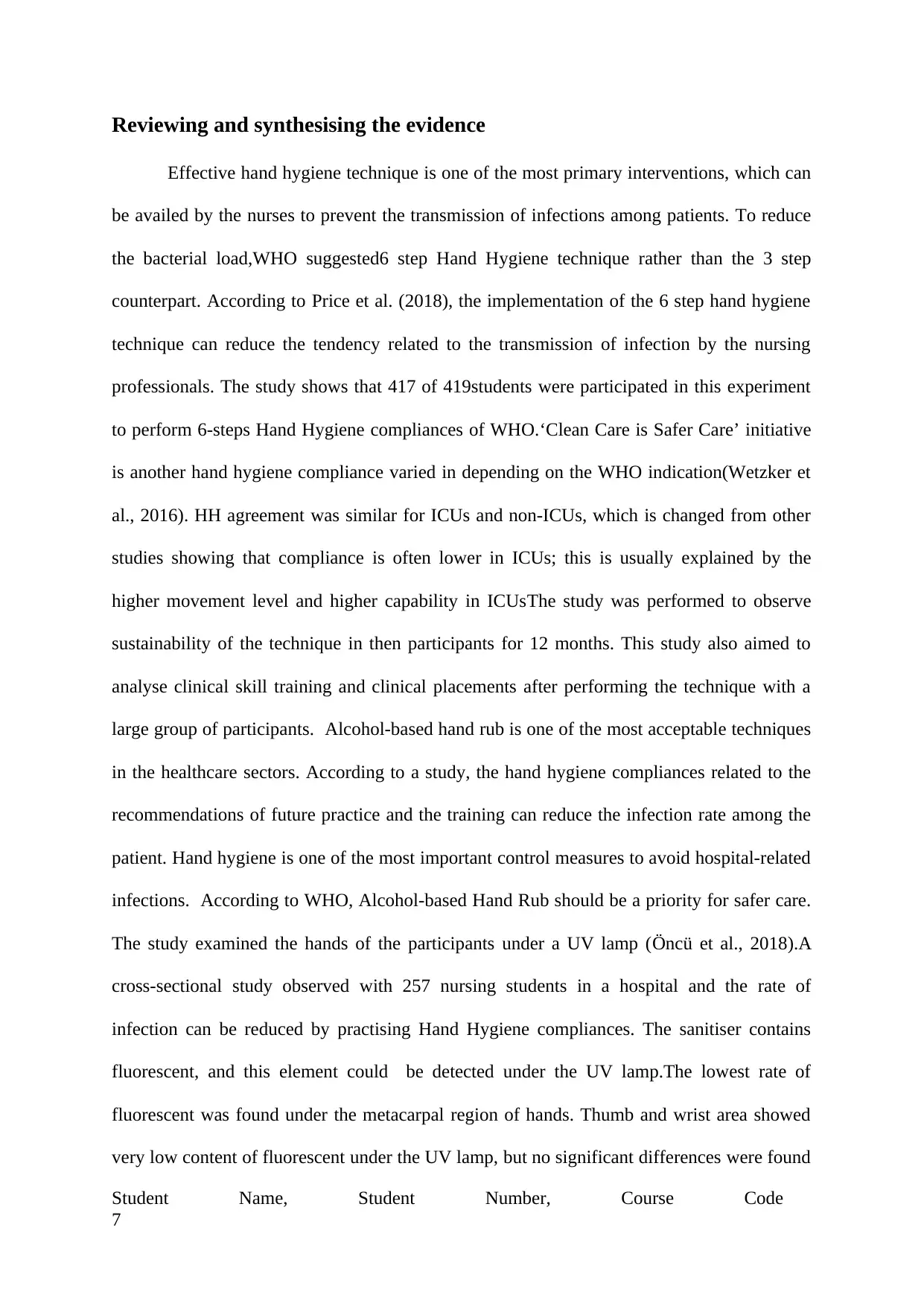
Reviewing and synthesising the evidence
Effective hand hygiene technique is one of the most primary interventions, which can
be availed by the nurses to prevent the transmission of infections among patients. To reduce
the bacterial load,WHO suggested6 step Hand Hygiene technique rather than the 3 step
counterpart. According to Price et al. (2018), the implementation of the 6 step hand hygiene
technique can reduce the tendency related to the transmission of infection by the nursing
professionals. The study shows that 417 of 419students were participated in this experiment
to perform 6-steps Hand Hygiene compliances of WHO.‘Clean Care is Safer Care’ initiative
is another hand hygiene compliance varied in depending on the WHO indication(Wetzker et
al., 2016). HH agreement was similar for ICUs and non-ICUs, which is changed from other
studies showing that compliance is often lower in ICUs; this is usually explained by the
higher movement level and higher capability in ICUsThe study was performed to observe
sustainability of the technique in then participants for 12 months. This study also aimed to
analyse clinical skill training and clinical placements after performing the technique with a
large group of participants. Alcohol-based hand rub is one of the most acceptable techniques
in the healthcare sectors. According to a study, the hand hygiene compliances related to the
recommendations of future practice and the training can reduce the infection rate among the
patient. Hand hygiene is one of the most important control measures to avoid hospital-related
infections. According to WHO, Alcohol-based Hand Rub should be a priority for safer care.
The study examined the hands of the participants under a UV lamp (Öncü et al., 2018).A
cross-sectional study observed with 257 nursing students in a hospital and the rate of
infection can be reduced by practising Hand Hygiene compliances. The sanitiser contains
fluorescent, and this element could be detected under the UV lamp.The lowest rate of
fluorescent was found under the metacarpal region of hands. Thumb and wrist area showed
very low content of fluorescent under the UV lamp, but no significant differences were found
Student Name, Student Number, Course Code
7
Effective hand hygiene technique is one of the most primary interventions, which can
be availed by the nurses to prevent the transmission of infections among patients. To reduce
the bacterial load,WHO suggested6 step Hand Hygiene technique rather than the 3 step
counterpart. According to Price et al. (2018), the implementation of the 6 step hand hygiene
technique can reduce the tendency related to the transmission of infection by the nursing
professionals. The study shows that 417 of 419students were participated in this experiment
to perform 6-steps Hand Hygiene compliances of WHO.‘Clean Care is Safer Care’ initiative
is another hand hygiene compliance varied in depending on the WHO indication(Wetzker et
al., 2016). HH agreement was similar for ICUs and non-ICUs, which is changed from other
studies showing that compliance is often lower in ICUs; this is usually explained by the
higher movement level and higher capability in ICUsThe study was performed to observe
sustainability of the technique in then participants for 12 months. This study also aimed to
analyse clinical skill training and clinical placements after performing the technique with a
large group of participants. Alcohol-based hand rub is one of the most acceptable techniques
in the healthcare sectors. According to a study, the hand hygiene compliances related to the
recommendations of future practice and the training can reduce the infection rate among the
patient. Hand hygiene is one of the most important control measures to avoid hospital-related
infections. According to WHO, Alcohol-based Hand Rub should be a priority for safer care.
The study examined the hands of the participants under a UV lamp (Öncü et al., 2018).A
cross-sectional study observed with 257 nursing students in a hospital and the rate of
infection can be reduced by practising Hand Hygiene compliances. The sanitiser contains
fluorescent, and this element could be detected under the UV lamp.The lowest rate of
fluorescent was found under the metacarpal region of hands. Thumb and wrist area showed
very low content of fluorescent under the UV lamp, but no significant differences were found
Student Name, Student Number, Course Code
7
Paraphrase This Document
Need a fresh take? Get an instant paraphrase of this document with our AI Paraphraser
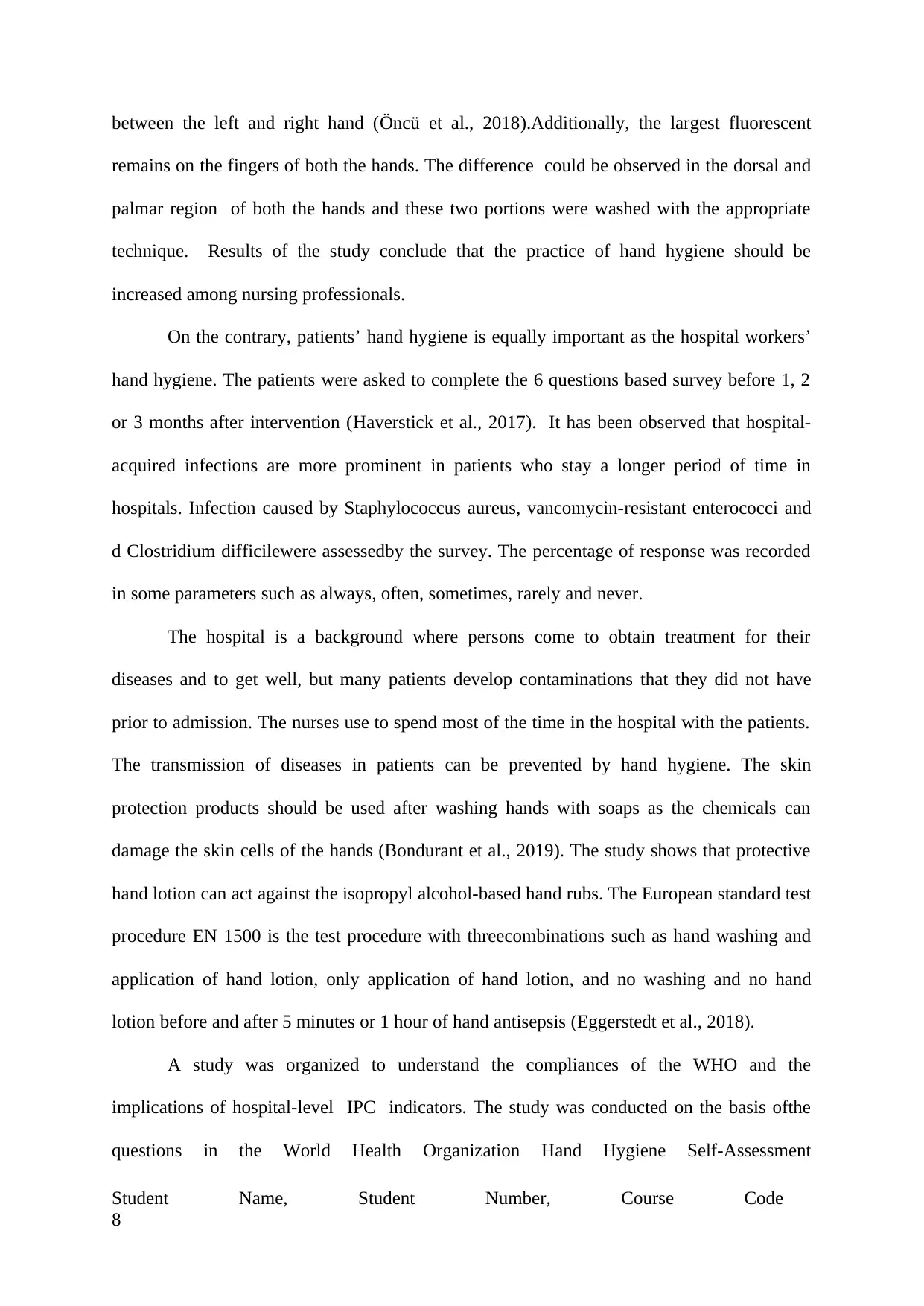
between the left and right hand (Öncü et al., 2018).Additionally, the largest fluorescent
remains on the fingers of both the hands. The difference could be observed in the dorsal and
palmar region of both the hands and these two portions were washed with the appropriate
technique. Results of the study conclude that the practice of hand hygiene should be
increased among nursing professionals.
On the contrary, patients’ hand hygiene is equally important as the hospital workers’
hand hygiene. The patients were asked to complete the 6 questions based survey before 1, 2
or 3 months after intervention (Haverstick et al., 2017). It has been observed that hospital-
acquired infections are more prominent in patients who stay a longer period of time in
hospitals. Infection caused by Staphylococcus aureus, vancomycin-resistant enterococci and
d Clostridium difficilewere assessedby the survey. The percentage of response was recorded
in some parameters such as always, often, sometimes, rarely and never.
The hospital is a background where persons come to obtain treatment for their
diseases and to get well, but many patients develop contaminations that they did not have
prior to admission. The nurses use to spend most of the time in the hospital with the patients.
The transmission of diseases in patients can be prevented by hand hygiene. The skin
protection products should be used after washing hands with soaps as the chemicals can
damage the skin cells of the hands (Bondurant et al., 2019). The study shows that protective
hand lotion can act against the isopropyl alcohol-based hand rubs. The European standard test
procedure EN 1500 is the test procedure with threecombinations such as hand washing and
application of hand lotion, only application of hand lotion, and no washing and no hand
lotion before and after 5 minutes or 1 hour of hand antisepsis (Eggerstedt et al., 2018).
A study was organized to understand the compliances of the WHO and the
implications of hospital-level IPC indicators. The study was conducted on the basis ofthe
questions in the World Health Organization Hand Hygiene Self-Assessment
Student Name, Student Number, Course Code
8
remains on the fingers of both the hands. The difference could be observed in the dorsal and
palmar region of both the hands and these two portions were washed with the appropriate
technique. Results of the study conclude that the practice of hand hygiene should be
increased among nursing professionals.
On the contrary, patients’ hand hygiene is equally important as the hospital workers’
hand hygiene. The patients were asked to complete the 6 questions based survey before 1, 2
or 3 months after intervention (Haverstick et al., 2017). It has been observed that hospital-
acquired infections are more prominent in patients who stay a longer period of time in
hospitals. Infection caused by Staphylococcus aureus, vancomycin-resistant enterococci and
d Clostridium difficilewere assessedby the survey. The percentage of response was recorded
in some parameters such as always, often, sometimes, rarely and never.
The hospital is a background where persons come to obtain treatment for their
diseases and to get well, but many patients develop contaminations that they did not have
prior to admission. The nurses use to spend most of the time in the hospital with the patients.
The transmission of diseases in patients can be prevented by hand hygiene. The skin
protection products should be used after washing hands with soaps as the chemicals can
damage the skin cells of the hands (Bondurant et al., 2019). The study shows that protective
hand lotion can act against the isopropyl alcohol-based hand rubs. The European standard test
procedure EN 1500 is the test procedure with threecombinations such as hand washing and
application of hand lotion, only application of hand lotion, and no washing and no hand
lotion before and after 5 minutes or 1 hour of hand antisepsis (Eggerstedt et al., 2018).
A study was organized to understand the compliances of the WHO and the
implications of hospital-level IPC indicators. The study was conducted on the basis ofthe
questions in the World Health Organization Hand Hygiene Self-Assessment
Student Name, Student Number, Course Code
8
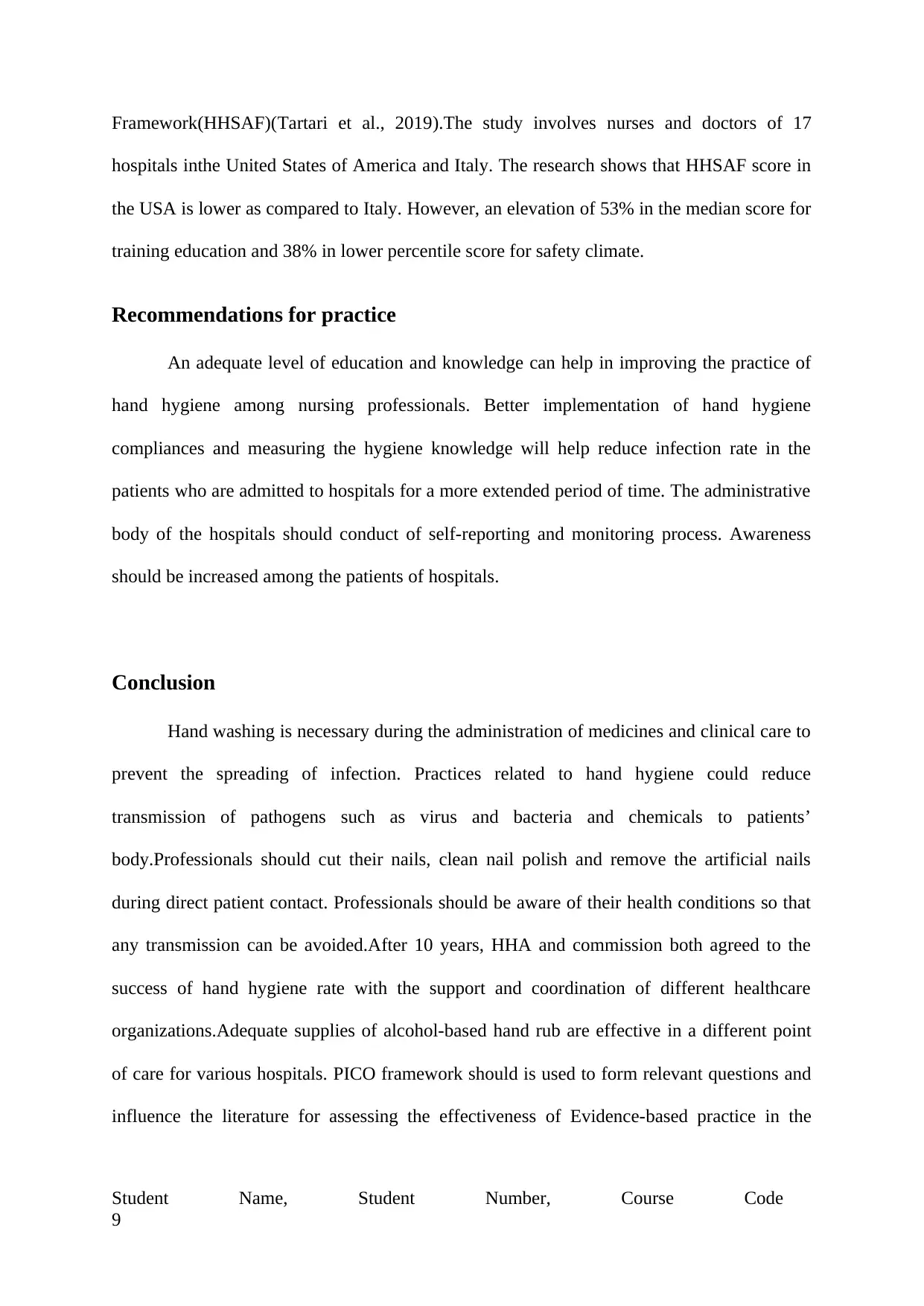
Framework(HHSAF)(Tartari et al., 2019).The study involves nurses and doctors of 17
hospitals inthe United States of America and Italy. The research shows that HHSAF score in
the USA is lower as compared to Italy. However, an elevation of 53% in the median score for
training education and 38% in lower percentile score for safety climate.
Recommendations for practice
An adequate level of education and knowledge can help in improving the practice of
hand hygiene among nursing professionals. Better implementation of hand hygiene
compliances and measuring the hygiene knowledge will help reduce infection rate in the
patients who are admitted to hospitals for a more extended period of time. The administrative
body of the hospitals should conduct of self-reporting and monitoring process. Awareness
should be increased among the patients of hospitals.
Conclusion
Hand washing is necessary during the administration of medicines and clinical care to
prevent the spreading of infection. Practices related to hand hygiene could reduce
transmission of pathogens such as virus and bacteria and chemicals to patients’
body.Professionals should cut their nails, clean nail polish and remove the artificial nails
during direct patient contact. Professionals should be aware of their health conditions so that
any transmission can be avoided.After 10 years, HHA and commission both agreed to the
success of hand hygiene rate with the support and coordination of different healthcare
organizations.Adequate supplies of alcohol-based hand rub are effective in a different point
of care for various hospitals. PICO framework should is used to form relevant questions and
influence the literature for assessing the effectiveness of Evidence-based practice in the
Student Name, Student Number, Course Code
9
hospitals inthe United States of America and Italy. The research shows that HHSAF score in
the USA is lower as compared to Italy. However, an elevation of 53% in the median score for
training education and 38% in lower percentile score for safety climate.
Recommendations for practice
An adequate level of education and knowledge can help in improving the practice of
hand hygiene among nursing professionals. Better implementation of hand hygiene
compliances and measuring the hygiene knowledge will help reduce infection rate in the
patients who are admitted to hospitals for a more extended period of time. The administrative
body of the hospitals should conduct of self-reporting and monitoring process. Awareness
should be increased among the patients of hospitals.
Conclusion
Hand washing is necessary during the administration of medicines and clinical care to
prevent the spreading of infection. Practices related to hand hygiene could reduce
transmission of pathogens such as virus and bacteria and chemicals to patients’
body.Professionals should cut their nails, clean nail polish and remove the artificial nails
during direct patient contact. Professionals should be aware of their health conditions so that
any transmission can be avoided.After 10 years, HHA and commission both agreed to the
success of hand hygiene rate with the support and coordination of different healthcare
organizations.Adequate supplies of alcohol-based hand rub are effective in a different point
of care for various hospitals. PICO framework should is used to form relevant questions and
influence the literature for assessing the effectiveness of Evidence-based practice in the
Student Name, Student Number, Course Code
9
⊘ This is a preview!⊘
Do you want full access?
Subscribe today to unlock all pages.

Trusted by 1+ million students worldwide
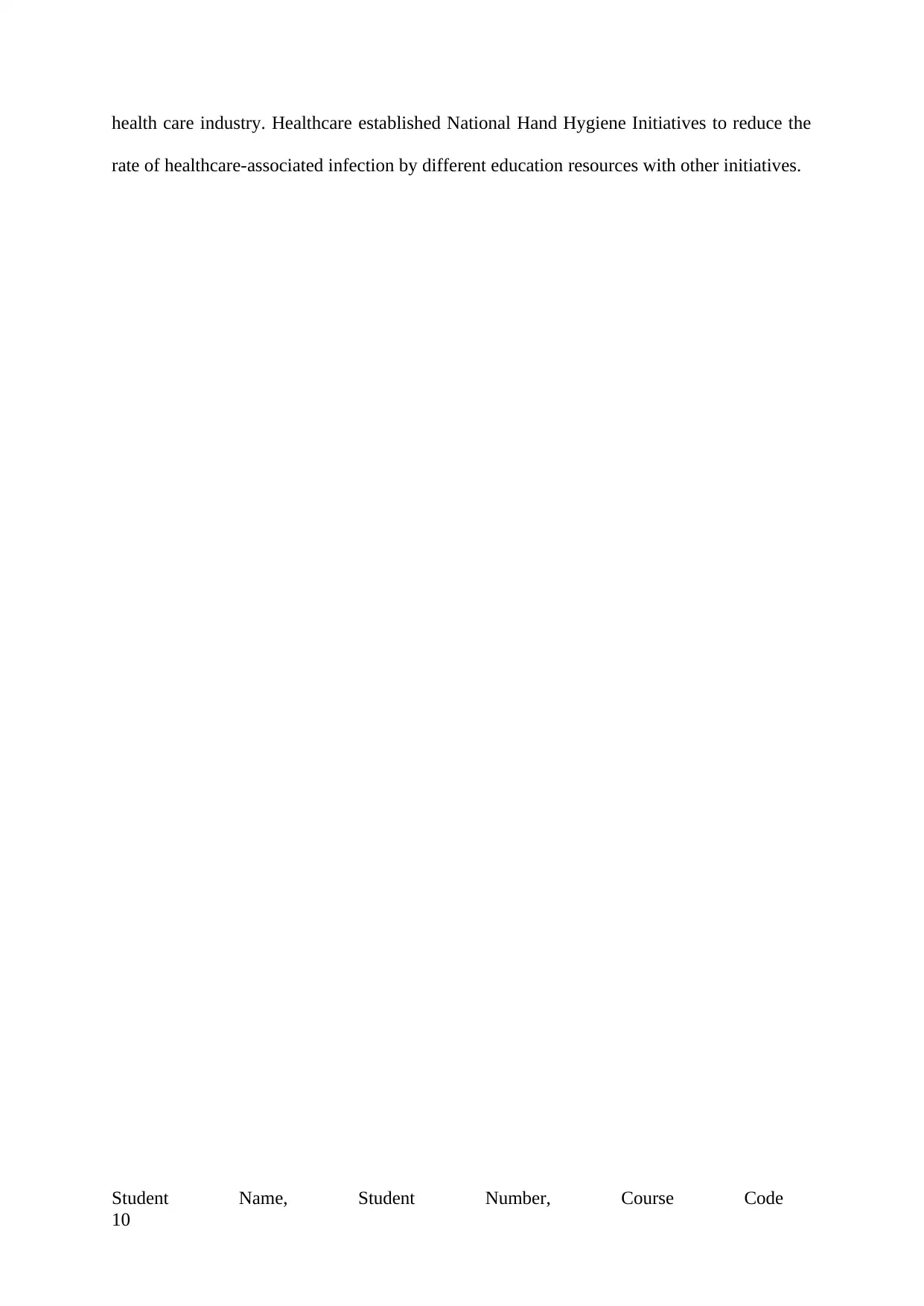
health care industry. Healthcare established National Hand Hygiene Initiatives to reduce the
rate of healthcare-associated infection by different education resources with other initiatives.
Student Name, Student Number, Course Code
10
rate of healthcare-associated infection by different education resources with other initiatives.
Student Name, Student Number, Course Code
10
Paraphrase This Document
Need a fresh take? Get an instant paraphrase of this document with our AI Paraphraser
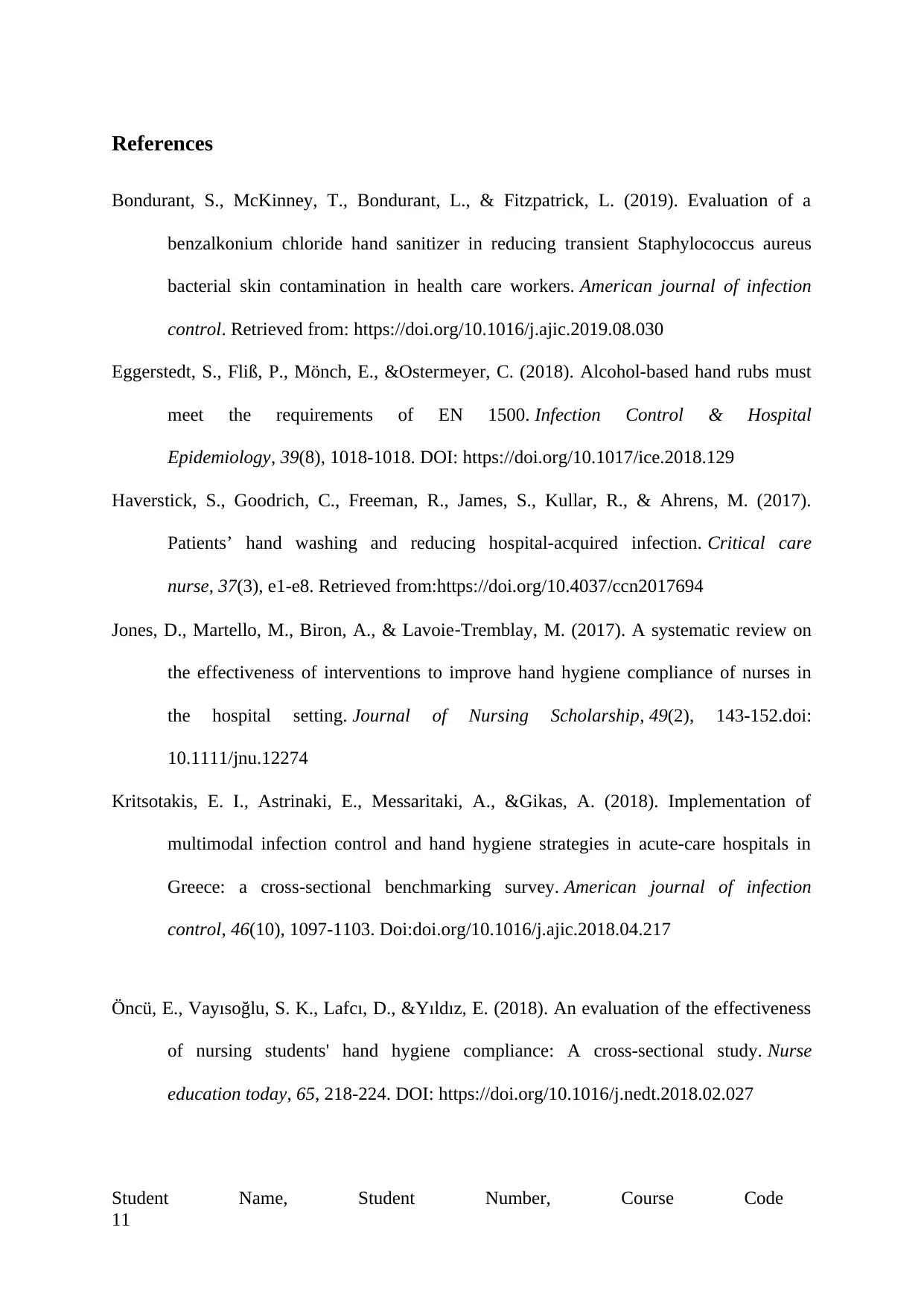
References
Bondurant, S., McKinney, T., Bondurant, L., & Fitzpatrick, L. (2019). Evaluation of a
benzalkonium chloride hand sanitizer in reducing transient Staphylococcus aureus
bacterial skin contamination in health care workers. American journal of infection
control. Retrieved from: https://doi.org/10.1016/j.ajic.2019.08.030
Eggerstedt, S., Fliß, P., Mönch, E., &Ostermeyer, C. (2018). Alcohol-based hand rubs must
meet the requirements of EN 1500. Infection Control & Hospital
Epidemiology, 39(8), 1018-1018. DOI: https://doi.org/10.1017/ice.2018.129
Haverstick, S., Goodrich, C., Freeman, R., James, S., Kullar, R., & Ahrens, M. (2017).
Patients’ hand washing and reducing hospital-acquired infection. Critical care
nurse, 37(3), e1-e8. Retrieved from:https://doi.org/10.4037/ccn2017694
Jones, D., Martello, M., Biron, A., & Lavoie‐Tremblay, M. (2017). A systematic review on
the effectiveness of interventions to improve hand hygiene compliance of nurses in
the hospital setting. Journal of Nursing Scholarship, 49(2), 143-152.doi:
10.1111/jnu.12274
Kritsotakis, E. I., Astrinaki, E., Messaritaki, A., &Gikas, A. (2018). Implementation of
multimodal infection control and hand hygiene strategies in acute-care hospitals in
Greece: a cross-sectional benchmarking survey. American journal of infection
control, 46(10), 1097-1103. Doi:doi.org/10.1016/j.ajic.2018.04.217
Öncü, E., Vayısoğlu, S. K., Lafcı, D., &Yıldız, E. (2018). An evaluation of the effectiveness
of nursing students' hand hygiene compliance: A cross-sectional study. Nurse
education today, 65, 218-224. DOI: https://doi.org/10.1016/j.nedt.2018.02.027
Student Name, Student Number, Course Code
11
Bondurant, S., McKinney, T., Bondurant, L., & Fitzpatrick, L. (2019). Evaluation of a
benzalkonium chloride hand sanitizer in reducing transient Staphylococcus aureus
bacterial skin contamination in health care workers. American journal of infection
control. Retrieved from: https://doi.org/10.1016/j.ajic.2019.08.030
Eggerstedt, S., Fliß, P., Mönch, E., &Ostermeyer, C. (2018). Alcohol-based hand rubs must
meet the requirements of EN 1500. Infection Control & Hospital
Epidemiology, 39(8), 1018-1018. DOI: https://doi.org/10.1017/ice.2018.129
Haverstick, S., Goodrich, C., Freeman, R., James, S., Kullar, R., & Ahrens, M. (2017).
Patients’ hand washing and reducing hospital-acquired infection. Critical care
nurse, 37(3), e1-e8. Retrieved from:https://doi.org/10.4037/ccn2017694
Jones, D., Martello, M., Biron, A., & Lavoie‐Tremblay, M. (2017). A systematic review on
the effectiveness of interventions to improve hand hygiene compliance of nurses in
the hospital setting. Journal of Nursing Scholarship, 49(2), 143-152.doi:
10.1111/jnu.12274
Kritsotakis, E. I., Astrinaki, E., Messaritaki, A., &Gikas, A. (2018). Implementation of
multimodal infection control and hand hygiene strategies in acute-care hospitals in
Greece: a cross-sectional benchmarking survey. American journal of infection
control, 46(10), 1097-1103. Doi:doi.org/10.1016/j.ajic.2018.04.217
Öncü, E., Vayısoğlu, S. K., Lafcı, D., &Yıldız, E. (2018). An evaluation of the effectiveness
of nursing students' hand hygiene compliance: A cross-sectional study. Nurse
education today, 65, 218-224. DOI: https://doi.org/10.1016/j.nedt.2018.02.027
Student Name, Student Number, Course Code
11
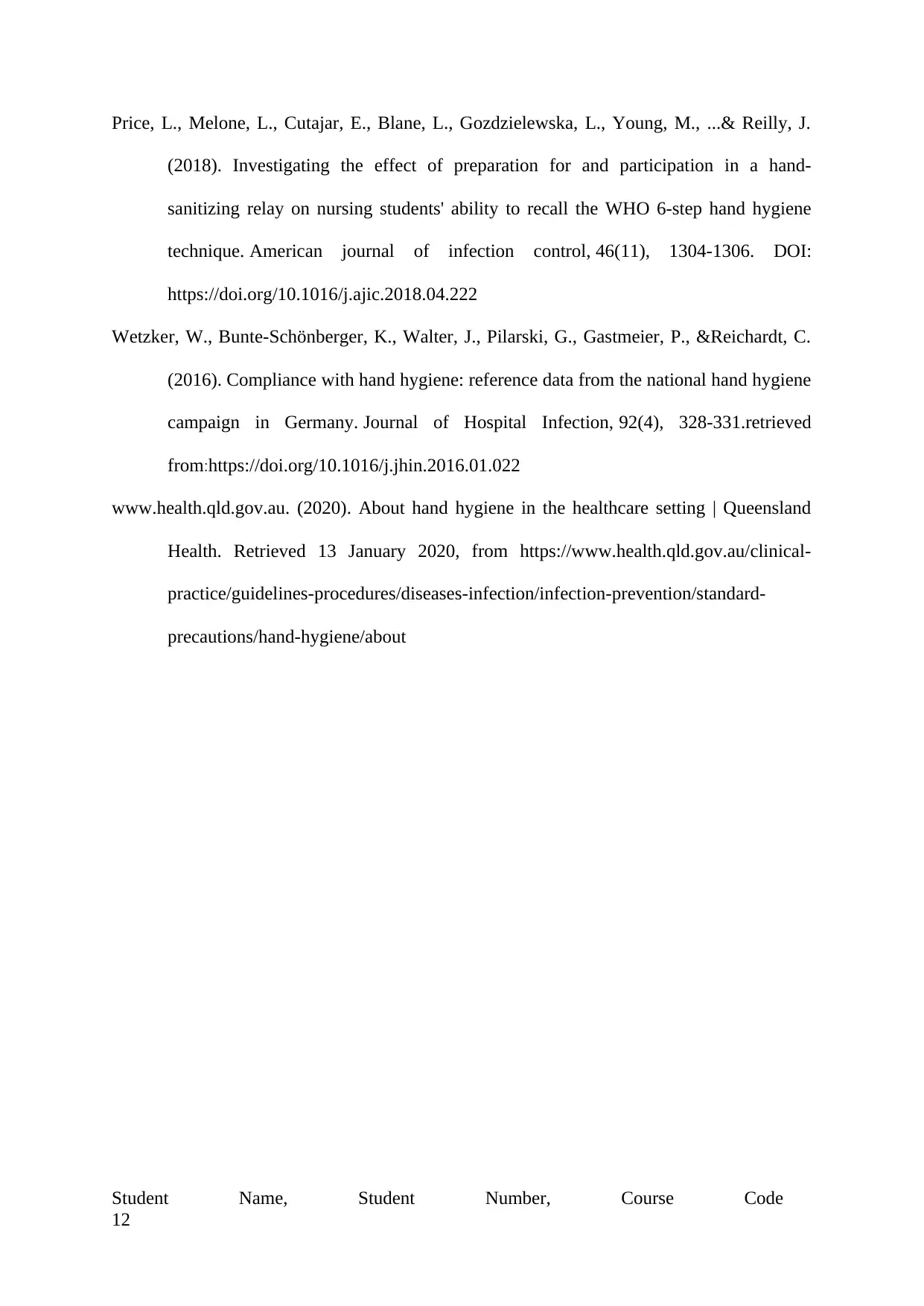
Price, L., Melone, L., Cutajar, E., Blane, L., Gozdzielewska, L., Young, M., ...& Reilly, J.
(2018). Investigating the effect of preparation for and participation in a hand-
sanitizing relay on nursing students' ability to recall the WHO 6-step hand hygiene
technique. American journal of infection control, 46(11), 1304-1306. DOI:
https://doi.org/10.1016/j.ajic.2018.04.222
Wetzker, W., Bunte-Schönberger, K., Walter, J., Pilarski, G., Gastmeier, P., &Reichardt, C.
(2016). Compliance with hand hygiene: reference data from the national hand hygiene
campaign in Germany. Journal of Hospital Infection, 92(4), 328-331.retrieved
from:https://doi.org/10.1016/j.jhin.2016.01.022
www.health.qld.gov.au. (2020). About hand hygiene in the healthcare setting | Queensland
Health. Retrieved 13 January 2020, from https://www.health.qld.gov.au/clinical-
practice/guidelines-procedures/diseases-infection/infection-prevention/standard-
precautions/hand-hygiene/about
Student Name, Student Number, Course Code
12
(2018). Investigating the effect of preparation for and participation in a hand-
sanitizing relay on nursing students' ability to recall the WHO 6-step hand hygiene
technique. American journal of infection control, 46(11), 1304-1306. DOI:
https://doi.org/10.1016/j.ajic.2018.04.222
Wetzker, W., Bunte-Schönberger, K., Walter, J., Pilarski, G., Gastmeier, P., &Reichardt, C.
(2016). Compliance with hand hygiene: reference data from the national hand hygiene
campaign in Germany. Journal of Hospital Infection, 92(4), 328-331.retrieved
from:https://doi.org/10.1016/j.jhin.2016.01.022
www.health.qld.gov.au. (2020). About hand hygiene in the healthcare setting | Queensland
Health. Retrieved 13 January 2020, from https://www.health.qld.gov.au/clinical-
practice/guidelines-procedures/diseases-infection/infection-prevention/standard-
precautions/hand-hygiene/about
Student Name, Student Number, Course Code
12
⊘ This is a preview!⊘
Do you want full access?
Subscribe today to unlock all pages.

Trusted by 1+ million students worldwide
1 out of 12
Related Documents
Your All-in-One AI-Powered Toolkit for Academic Success.
+13062052269
info@desklib.com
Available 24*7 on WhatsApp / Email
![[object Object]](/_next/static/media/star-bottom.7253800d.svg)
Unlock your academic potential
Copyright © 2020–2025 A2Z Services. All Rights Reserved. Developed and managed by ZUCOL.





